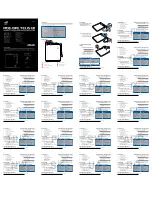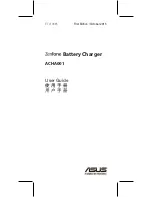
1.
2.
3.
4.
5.
6.
7.
Your battery charger is designed to be permanently mounted on-board, and can be
mounted either vertically or horizontally.
Always mount your charger in a compartment area that can be properly ventilated during use.
Do NOT mix battery types on-board. All batteries should be of the same age and in
good operating condition.
Do NOT make any electrical connections to the charger or batteries until th steps
below are completed:
Easy Steps for Installation:
Select a mounting location that allows for free air ventilation with a minimum of
6 inches of clear unobstructed space around and in front of your Battery
Charger. Open all battery and engine compartments and ventilate for at least
15 minutes before starting the installation of the charger. Ensure all battery
cables can reach each of the batteries.
Note: For installations requiring an extension of the DC battery charger
cables,please call or visit your retailer or dealer to purchase a 5 foot or 15 foot
battery charger DC cable extenders.
Do not install charger on carpeted, upholstered, vinyl, or varnished areas.
Make sure to place the charger in an accessible area where all indicators are
clearly visible. Install this unit on a hard surface.
Using the battery charger or the enclosed template, mark the position of each
mounting hole. Ensure the mounting screws will not puncture or protrude into a
live well, a fuel or oil tank or the bottom of the boat.
Using a 1/8" drill bit, drill pilot holes in the (4) marked locations as described in
step Apply a silicon sealer in each of the mounting locations to waterproof the
screw holes.
Position the charger over the mounting holes and secure with a power screw-
driver by installing 4 stainless steel # 10 screws.
(mounting screws are not
supplied)
Prepare each battery in advance by cleaning each terminal post with a wire
brush until a shiny surface is obtained.
Run cables free from sharp objects and secure the cables with cable ties. Coil
excess cable, do not cut or shorten the length of the cables, as in-line fuses
1/8" pilot hole with silicon sealer
IMPORTANT NOTICE
Confirm the surface you will be mounting
the charger to is adequate in strength and
thickness to hold the battery charger in
place with the mounting screws you have
selected.
Maintain an obstruction free area of 6
inches around the Battery Charger.
Installation
11
12
8.
9.
10.
11.
are located 4 inches from the end of each red (positive) cable. In addition,there
are fuses in all but one of the black (negative) leads. These fuses protect
hecharger and output cables in the event of a short or reverse polarity. We
recommend the use of wire ties or cable clamps to provide strain relief for the
cables and to reduce the risk of damage to the cables or connections.
Connect the DC output cables as illustrated on pages 16-23. Make sure the
(black) wires are connected to the negative side of the battery and the red
wires are connected to the positive side of the battery
Make sure all DC connections are correct, tight, and free from corrosion.
Locate the AC power cord in an open-air area of your boat at least 21 inches
from the charger, batteries, and fuel fill lines.
Connect a heavy duty UL approved extension cord to your charger first. After
connecting the extension cord to the charger, proceed to plug the extension
cord to a nearby 240VAC GFCI protected (Ground Fault Circuit Interrupt)
outlet. Always remove the extension cord from the 240 VAC outlet first when
charging is completed, followed by unplugging the charger. You are now
connected and charging your batteries, and can monitor the progress by
viewing the LEDstatus indicators.
Important Note: Your battery charger will not operate properly if it is not connected properly
to each battery. Reminder, each DC jacketed bank cable must be properly connected to
individual12V batteries. Number of the DC jacketed bank cables equals the number of
batteries that must be individually connected. For example, a 3 bank battery charger must
be connected to 3 individual 12V batteries, as Illustrated on pages 16-23. For charger
setup, simply choose the illustration that has the same number of charger output bank
cables as your battery charger in hand and wire exactly as shown (choose the illustration
that matches your application) for proper charger operation.
Installation






























